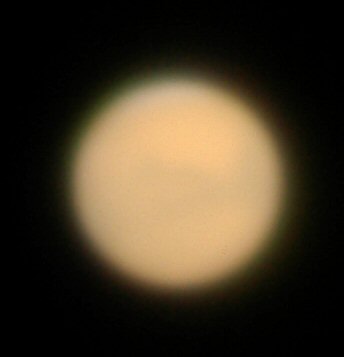 |
Last year Mars came very close to the earth. I used my digital camera to take the pictures of Mars for the first time. I used the software registax to composite 14 pictures to make this one.
Data: 2005/11/4 1h07m-25m
PENTAX 105SD f=1000mm D=105mm
PENTAX Or-6mm Takahashi EM-200
PENTAX *istD
|
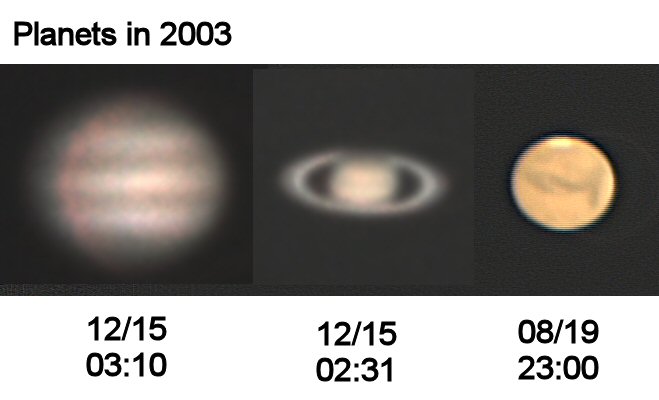 |
I videotaped three planets of 2003, captured the images into my computer, and processed the images with the software registax. I think there is still more to make better pictures.
Data:
Meade 2120LX5 D=254mm f=2500mm
Meade PL-26mm
Canon MV1
|
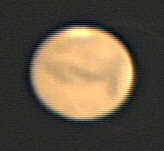 |
This year Mars came quite close to the earth. I videotaped it, captured the image and processed them with the software registax. I really think it is a piece of cake.
Data: 2003/8/19 23h00m
Meade 2120LX5 D=254mm f=2500mm
Meade PL-26mm
Canon MV1
|
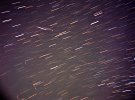 |
The Leonides in 2001 was fantastic. My friend and I went to Aoyama Highland in Mie Prefecture. We saw more than tens of thousands of shooting stars from 1 a.m. to 4 a.m. on November 19. Around 2:30 thirty of them a minute, and around 3:15 more than sixty a minute. We were surprised to see many come out at once.
Data:2001/11/19 1:31-1:50
1:50-2:10 2:10-2:30
2:30-2:45 2:45-3:00
3:00-3:15 3:15-3:36
3:36-3:51
Mamiya M645 500 f=45mm F2.8 Fuji400
|
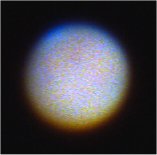 |
This year Mars came very close to the earth many years after the last, but I couldn't take a good photo. In two years it will come quite close, so I will do my best next time.
Data: 2001/7/1 22h09m00s-04s,10m00s-03s (composited)
PENTAX 105SD f=1000mm D=105mm
PENTAX Or-6mm Takahashi Em-200
PENTAX LX Fuji Super G800
|
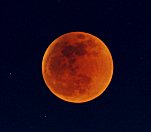 |
We saw a lunar eclips ten years after the last. The last time was on February 10 in 1990. During these ten years, I got married and had two daughters. I have changed a lot, but the universe is still the same.
Data: 2000/7/16 22h57m00s-45s
PENTAX 105SD + TAKAHASHI EM200
Mamiya M645 Fuji 400
|
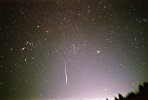 |
I could not see the Leonides in 1999 because of the cloud, so I challenged the Geminids. My friend and I were trembling in the cold air on Aoyama Highlands in Mie Prefecture. I got a nice picture out of 20. It was published in Gekkan Tenmon in May, 2000. In 2001, we will have another good chance, so I want to give it another try.
Data: 99/12/14 26h28m000s-33m00s
COSINA CT-1Super PENTAX SMC24mm F2.8 (F2.8)
KONICA JX400 VIXEN NEW POLARIS
|
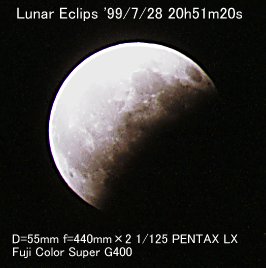 |
Have you seen the partial lunar eclips on July 28, 1999? It was cloudy in Osaka,
but I was lucky enough to see it. Its best was only seen through the clouds,
so this is twenty minutes afterwards. We have seldom seen lunar eclips these several years,
but we will be able to see it more often from now on.
Data: 99/7/28 20h51m20s 1/125s
VIXEN D=55mm f=440mm x2 (Kenko Teleplus 4)
PENTAX LX Fuji Super G400
|
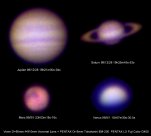
Data: 98/12/28 Jupiter: 19h21m00s-04s Saturn: 19h25m45s-53s
99/5/1
Mars: 23h03m15s-16s
Venus: 18h57m30s 1/2s
VIXEN D=80mm f=910mm PENTAX Or-6mm
PENTAX LX Fuji G400 |
I have been less busy
these days and I used my second handed Takahashi's
equatorial telescope EM-200 which I bought two years ago.
I used twenty-year-old 8cm acromat lens telescope to take
pictures of Jupiter and Saturn. I hope they are the same
scale. Jupiter is brighter than Saturn, so we can
take pictures of Jupiter quicker than those of Saturn.
That means we can get better pictures of Jupiter than
those of Saturn. Acromat lens, however, produces so much
color aberration, the picture cannot be so clear. I need
bigger fluorite lens to get clearer pictures but it cost
me a fortune. . . .but I got it. Look forward to what will come out next.
|
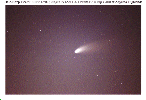 |
Though we could see Hale-Bopp Comet in
Higashi Osaka City, it was the rarest opportunity for us,
so I went to Aoyama Highland in Mie with my family. It
was the most marvelous comet I've ever seen. Data:
1997.3.31 19:12:00 (30s)
PENTAX LX 135mm F2.8 Fuji G400
|
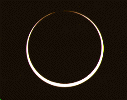 |
This is the picture of an annular eclipse in
Okinawa on September 23, 1987. It was worth visiting
there. As the eclipse went on, it was becoming dimmer and
dimmer, cooler and cooler. The same thing happened in the
partial solar eclipse on March 9, 1997. You can enjoy the
continuous slide show from 9:50 to 11:35 p.m. every five
minutes. The rate changes into about every two minutes
shortly before and after the annular eclipse. |










